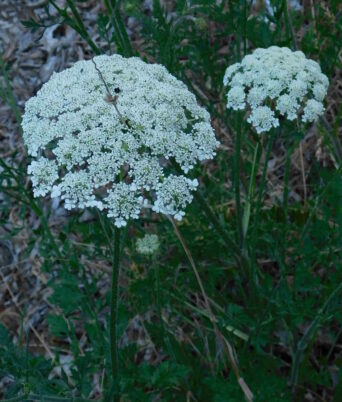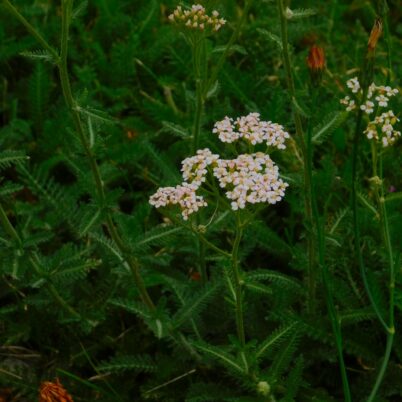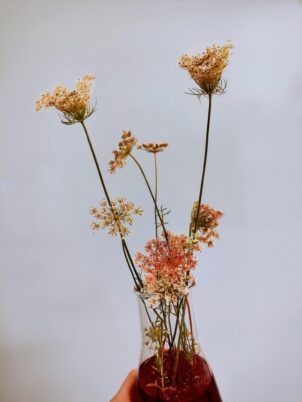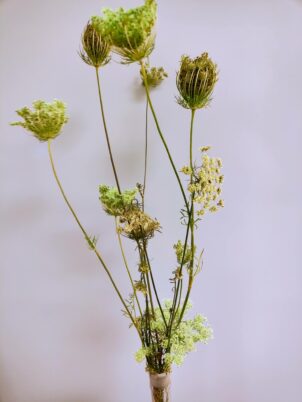The Queen with Hairy Legs: A Royal Beauty on Campus
The Queen Anne’s Lace: Stubborn, Regal, and Here to Stay
by Marcia Wilson

From midsummer until frost, long, leggy white blooms sway in the winds of South Puget Sound. These are Daucus carota, Queen Anne’s Lace (QAL), the wild carrot. In abandoned lands, the fields look like bobbing snowballs on slim stalks. The sight makes some sigh with delight, while others flinch. The different reactions are rooted in the logistics of what makes a carrot, a carrot.
Royal Pedigree
How did carrots get involved with the name of Queen Anne II of England? The English once ate skirrits, a root crop that tasted something like a potato and a carrot. It had a lacy white flower, but nothing as extravagant as the flower from the carrot. Carrots began to show up in English cooking around the 16th-17th centuries. Circumstantial evidence suggests that as the carrot replaced the skirrit, Queen Anne’s coincidental reign became aligned with the newcomer. Royalty was more likely to eat the new and exotic vegetable, with the common population gradually following their example.
Slicers and Dicers for Washington State
Only California grows more carrots than Washington State. This is astonishing for a public accustomed to state icons like apples and cherries, but it is a fact. Carrots’ high levels of nutrition and vitamins make them a reliable consumable and they store, pack, and travel well. Carrots are a reliable food source; sales show no sign of dropping. The Evergreen State devotes over 10,000 acres to carrot farming. These are in the form of “dicing or slicing” carrots. Dicers are shorter and thicker. This makes them efficient for the factory processing.
Small farms prefer fresh-eating, slicer carrots. Slicers are bred in a rainbow of colors: cherry red, white, pale pink, yellow, black, and violet with sunny starbursts in the core. All of these variations are from an ancient genetic code; close inspection of Queen Anne’s Laces will find subtle shades of all these colors in the stem and leaf.
From Farm to Feral
Wild carrots are small, woody, and have unpredictable flavors. They also stink. Washington State’s Noxious Weed Board put it on the Class C list in 1988. This classification designates it as of special concern for the agricultural industry, or if it is already a common nuisance.
“This [The Queen Anne’s Lace] plant is also on the Washington State quarantine list. It is prohibited to transport, buy, sell, offer for sale, or distribute plants or plant parts of quarantined species into or within the state of Washington or to sell, offer for sale, or distribute seed packets of seed, flower seed blends, or wildflower mixes of quarantined species into or within the state of Washington.”–WA State Noxious Weed Control Board
Agriculturally, it threatens native grasses and weakens the food value of the state’s croplands. Mammals grazing on the plant will give tainted milk. In high concentrations, it sickens cattle.
A 48-Karrot Conundrum
Wild or tame, carrots like the same soils and growing conditions. They easily hybridize and this damages the edibility of the commercial crop. A single QAL can produce up to 40,000 seeds. Thus, cultivated carrots are threatened by wild carrots. This threat is taken seriously by the Department of Agriculture. Last year the USA made over $1.82 billion in carrot sales. This is a lot of value for a small food plant!
Queen Anne’s Lace can be difficult to differentiate from poison hemlock. Unlike hemlock, QAL has hairy stems. Foragers will say, “The Queen has hairy legs!” Because the dying blooms close up, they are also called “bird’s-nest” flowers, which helps with identification.

Another look-alike is the common yarrow (shown). Yarrow is not toxic but it is not palatable.
Queen Anne’s Lace has the interesting property of pulling pigment into itself. If cut flowers are placed in a vial of food coloring, the flowers will soak up the colors. It makes an unforgettable lesson plan in botany, soil pollution, and biology.
Every month, Dr. Derek Faust from the Environmental Science Program coordinates invasive and non-native plant removals on the Flett property across the street. In other circumstances, Queen Anne’s Lace would qualify for more urgent removal. But the property is a former farmland, not a working one and the college is striving to restore it to a state closer to its native ecology. Other, faster-growing species like the non-native blackberries and Scotch broom, take priority for eradication.
With that said, anyone who wants to cut down these flowers and make their own colored water experiments are welcome to do so!

